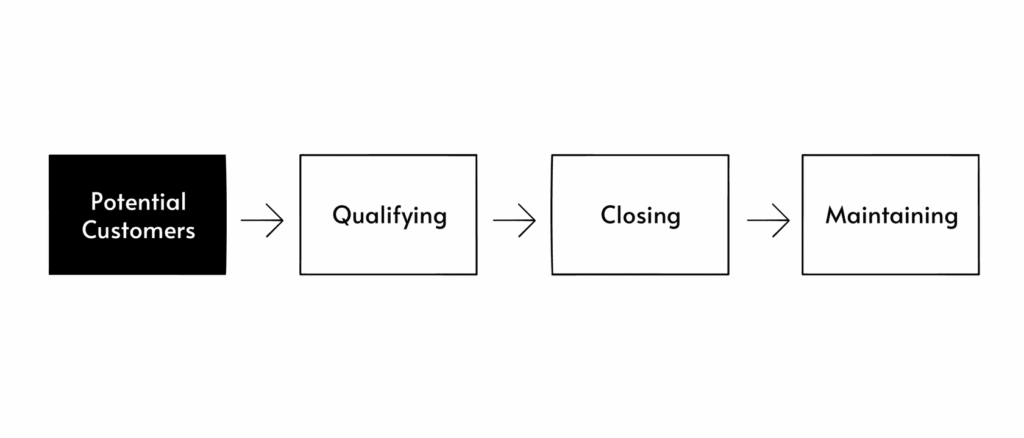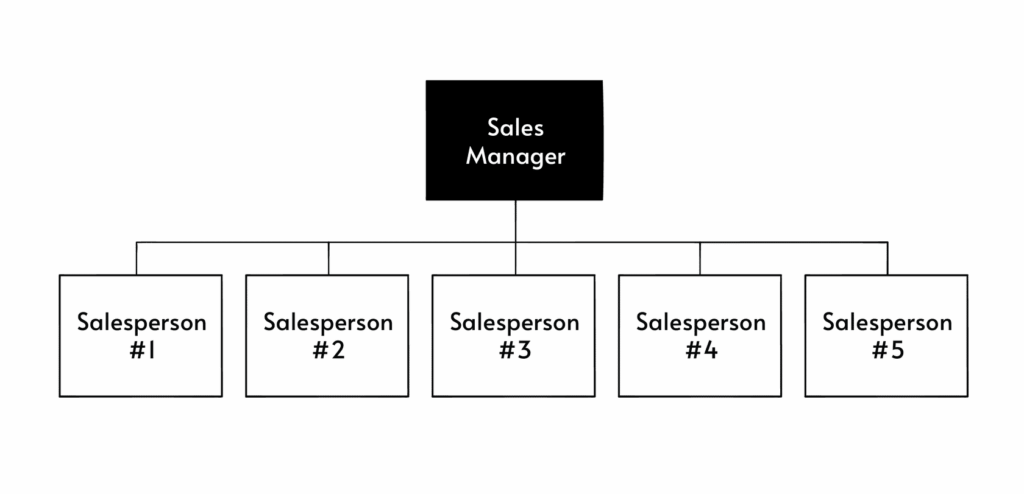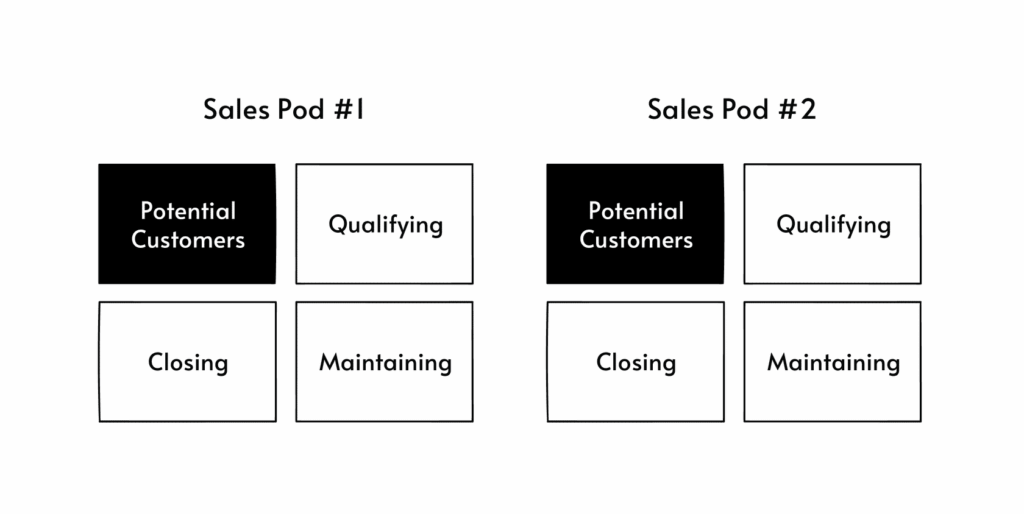Ways to Structure Your Sales Team
Roles describe the functions of individuals within a team, whereas a team’s structure dictates what roles are available and how they fit together to achieve a shared goal. Of course, there are multiple ways to set up a structure—there’s no one-size-fits-all solution. Below, you’ll see three examples to inspire you as you think about your ideal structure.
3 Structures
Click on each row to learn three ways you might structure your sales team and the strengths and limitations of each approach.
Structure 1: The Assembly Line

The first sales team structure is an assembly line. Most common in small to midsize companies, the assembly line breaks the sales process into parts, from prospecting and qualifying to closing and transitioning to customer success. An individual or team of people oversees each part before passing the potential customer along.
Like runners in a relay race—or parts of an assembly line—each individual or team takes ownership of a designated segment in the sales pipeline.
Strengths:
Creates a lower-stress environment where people can specialise in one part of the sales process
Boosts efficiency when handling lengthy and complex deals
Makes identifying and isolating issues across the sales process easier
Cultivates a team-oriented work culture
Limitations:
May cause friction when handing off customers from team to team or person to person
Can lead to a disconnect between team goals, department goals, and overall business goals
Team members may feel removed from other stages of the buyer’s journey
Structure 2: The Island

In an island model, each salesperson owns “their” potential customers from the beginning of the sales pipeline until the end. That includes qualifying, building relationships, closing sales, and more. For example, consider how a single real estate agent takes care of a client from the start of their house hunt through closing. This structure is most common among new companies just hiring their first sales reps, or industries that promote competition and independence.
Strengths:
Can be spun up quickly with a small team
Fosters competition among sales reps, often leading to higher sales numbers
Offers team members a high level of autonomy and ownership over their work
Creates a more connected or unified customer experience
Allows salespeople to forge strong, long-term bonds with customers
Limitations:
Can lead to hyper-competitiveness or even unethical behaviour, which can create a toxic work environment
Makes isolating and identifying issues across the sales process difficult
May lead to inefficiencies when managing large teams or complex deals
Can increase customer churn when sales reps leave the company
May stretch sales reps too thin
Structure 3: The Pod

The final structure is the pod. It’s essentially a mix of the other two structures, and it’s most commonly found in midsize to large companies. Instead of having one large sales team, the pod breaks your team into multiple groups or smaller units.
Each “pod” sells a particular product or targets a specific geographic location, industry vertical, or another subset of customers. For example, one pod handles international sales while another oversees domestic sales. Within each pod, team members still serve in the same specialised roles or functions as they do in assembly lines.
Strengths:
Combining the assembly line’s efficiency with the island’s independence and personal ownership
Allows for segmentation across territories, industries, or other criteria
Highly flexible and adaptable for organising and scaling teams
Can result in tightly knit teams that work well together
May increase team members’ connection to the buyer’s journey
Limitations:
Can be time-consuming and complex to set up initially
Can result in low performance if each person on a team doesn’t pull their weight
Which Structure Is Best?
Choosing the best structure for your sales team depends on your priorities and needs. Ask yourself the following prompts to get insight on which structure makes sense for your specific situation:
- Is my company a small, midsize, or large organisation, and do we expect to scale?
- Is my company a startup or an established business?
- Is my company culture built on collaboration—or do my salespeople excel when working independently?
- What structure do other sales teams use in my industry?
- How large or complex are our average deals?
- What are my team’s goals and challenges?
For example, if your team handles large and complex deals, you may want to avoid placing the responsibility on one person (an island structure) and opt for an assembly line structure instead. Or, if your team currently struggles to create a connected experience for prospective customers, you might want to experiment with a pod structure. The bottom line: The best structure is the one that works best for you.
Summary
Whether you’re newly forming, restructuring, or scaling your sales team, it pays to be strategic. First, establish clear roles within your chosen structure. Where do one person’s responsibilities end and another’s begin? Hunters, experts, closers, and leaders all play essential roles in winning deals and ensuring a smooth customer experience.
Then, Consider your industry, company size and culture, and the relative complexity of your deals to determine which team structure best fits your needs. Does an assembly line, island, or pod structure make the most sense? By establishing a strong team structure with clear roles, you can empower employees to fully commit to their part in achieving shared goals.
- Talk to your team directly. What’s working well? What isn’t? Solicit input to choose and maintain the roles and structure that will allow your team to shine.
One way to ensure a successful team structure is to identify the different personalities and strengths of each salesperson. In the next lesson, you’ll learn how to spot and help two contrasting types of sales personalities.
Click on “Mark Complete ✓“.

